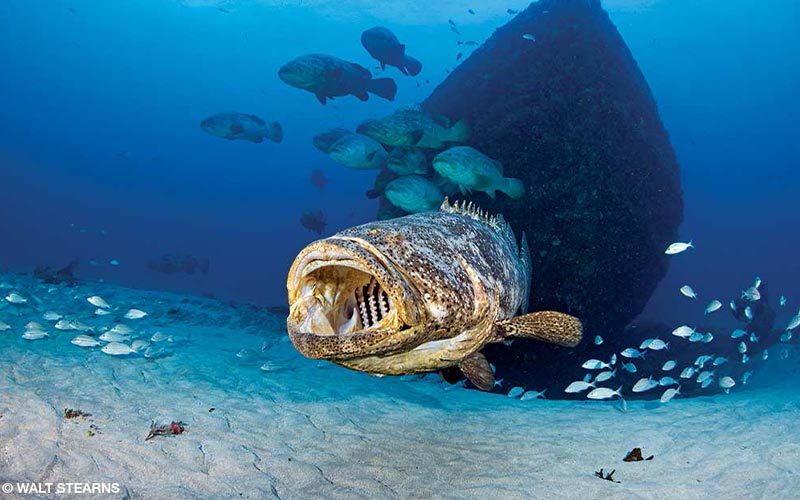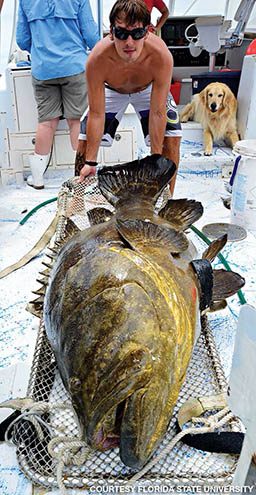Florida’s goliath groupers are one of my favorite fish. In addition to being quite large, the animals’ unflappable nature and unique appearance make them great photo subjects, especially off South Florida’s Palm Beach Coast. The visibility here is often very good, and the local goliath grouper population is robust. The presence of these giant groupers has created a big-ticket attraction for local dive operations, especially during August and September, when these fish aggregate in large numbers to spawn. Jumping in the water and coming face to face with 20, 30 or sometimes as many as 90 mature goliaths is a special treat. Although populations have rebounded dramatically around Florida, not everything is rosy for these big fish.
Back from the Brink
By the late 1980s overfishing had decimated Florida’s goliath groupers. In 1990 the South Atlantic Fishery Management Council and the Gulf of Mexico Fishery Management Council enacted an emergency moratorium against taking or possessing the fish in U.S. federal waters. Then the U.S. added the goliath grouper as a candidate to the Endangered Species List in 1991. Under the Magnuson-Stevens Fishery Conservation and Management Act, the National Marine Fisheries Service (NMFS) of the National Oceanic and Atmospheric Administration (NOAA) assesses fish stocks and ensures regulatory compliance for protected species. In the years since protection began, goliath grouper numbers have rebounded on both Florida’s east and west coasts, but their numbers were so low that spawning aggregations were not documented until 10 years after protection was put in place.
Today protection efforts are seen as a success, as mature fish can once again be found on reefs and wrecks, and spawning aggregations occur annually. But this recovery has also sparked strong emotions and divided opinions. Some interest groups want the goliaths to be eligible for commercial harvest, and others push for limited recreational access. Those in favor of continued protection believe the fish cannot handle the pressure of any harvest, which would quickly remove large breeders from the population and send their numbers crashing. This fear is not unfounded. The Atlantic goliath grouper (Epinephelus itajara) and its close relatives are in serious decline throughout the rest of their natural range. Outside of Florida, their numbers are now near zero, and organizations such as the International Union for Conservation of Nature and Natural Resources (IUCN) currently have them on the Red List as “critically endangered.”
While this argument goes on, an even darker specter has emerged to threaten these fish: mercury. The year goliaths were granted protection, the job of monitoring the species was put into the hands of scientists at NMFS and Florida State University (FSU). FSU research ecologist Chris Koenig, Ph.D., and his colleagues began a detailed study of the fish’s natural history. I was introduced to Koenig’s research during a goliath grouper spawning aggregation survey trip in the southern Gulf of Mexico in 2001.
Since then, Koenig has kept me informed about the latest findings as they continue to collect data using nonlethal capture and sampling methods on hundreds of goliath groupers, from juveniles to full adults more than 7 feet long. The most recent information came from a Marine Fisheries Initiative Program (MARFIN) report titled “Regional Age Structure, Reproductive Biology and Trophic Patterns of Adult Goliath Grouper in Florida,” which Koenig and fellow FSU biologist Felicia Coleman submitted to NOAA. In the report’s section on diet and the dynamics of heavy-metal contamination, FSU doctoral student Chris Malinowski reported levels of methylmercury in adult goliath groupers that were frightening, to say the least.
Heavy Metal
Methylmercury is particularly nasty stuff with a propensity to accumulate appreciably in the tissues of fish and to cause direct harm to both the fish and its human consumers. This highly toxic compound was the cause of one of the worst epidemics of mercury poisoning in modern history. In the spring of 1956 residents of the Japanese city Minamata came down with a range of symptoms including acute ataxia (severe loss of coordination), numbness in the hands and feet, visual distortion, and temporary and even permanent hearing and speech impairments. Even more dire symptoms of Minamata disease, as it became known, included insanity, paralysis and coma followed by death within weeks of the first onset of symptoms. It was eventually determined that these maladies were caused by eating fish contaminated with large amounts of mercury dumped into Minamata Bay from a nearby chemical plant. Birds, domestic animals and more than 900 people died from this contamination. Many more suffered sublethal effects.

To learn more about methylmercury, I contacted Malinowski, who has been working with Koenig since 2012. Malinowski’s work started as a preliminary study after reading a paper published by Florida Fish and Wildlife Conservation Commission (FWC) biologist Douglas H. Adams and Christian Sonne in 2013 about mercury concentrations in goliath groupers in one area of Florida’s west coast.
Adams and Sonne’s work was based on tissue samples from 56 goliath groupers (42 postmortem) collected from Gulf of Mexico and Atlantic Ocean waters off Florida. These samples showed methylmercury concentrations in the muscle tissue of fish at an average of 0.63 ug/g (micrograms per gram = parts per million [ppm]). Brain, gonad and kidney tissue samples produced similar results. The highest levels were in livers, with concentrations of 2.87 ppm in 4-inch juveniles to 22.68 ppm in older fish that were more than 7 feet long.
“The 2013 Adams and Sonne paper prompted my interest in learning how and where these fish were getting the mercury and how it impacts their health and survival,” Malinowski said. He explained that further research revealed not just patterns of accumulation but also that the elevated methylmercury levels are not a localized event but one affecting the fish through their entire range in Florida waters.

Goliaths spend the first five to six years of their lives among the mangroves found in estuarine habitats (that’s a notably long time for a fish to spend in a nursery environment). By the time they are ready to move offshore and populate coastal reefs and wrecks, they are around 3-4 feet long. Although they are technically old enough to breed at this point, another two to four years pass before they start joining reproductively active adults during the spawning season. Data show that goliaths don’t reach peak fecundity until around 12 to 15 years of age, with the most virile fish measuring 5.5-6.5 feet long and tipping the scales at 250-500 pounds.
Malinowski began finding methylmercury concentrations in the muscle tissues (filet portion) among 7- to 10-year-old fish at an average of 1.5 ppm, with maximum figures as high as 2.6 ppm. More disturbing, concentrations in older fish 5.5 feet long and longer were through the roof, with figures as high as 4.5 ppm.
The U.S. Food and Drug Administration (FDA) set an “action level” (above which it prohibits the sale of fish) for methylmercury levels in fish for consumption at 1.0 ppm. The U.S. Environmental Protection Agency (EPA) draws its red line for being dangerous to consume at 0.3 ppm, and the Natural Resources Defense Council (NRDC) draws its line at 0.5 ppm.
While two-thirds of commercially caught fish and shellfish are generally well below those numbers, some are significantly above that range. Tilefish from the tropical Atlantic and Gulf of Mexico test at the top of the EPA’s list, averaging 1.45 ppm of mercury. Swordfish and large species of sharks (mako, thresher, lemon, sandbar, etc.) come in second and third, averaging anywhere between 0.97 ppm and 1.00 ppm of mercury, while king mackerel takes fourth place, averaging 0.73 ppm of mercury.
The EPA’s current reference dose (the amount of methylmercury to which an individual can be exposed on a daily basis without adverse health consequences) is 0.1 micrograms per kilogram of body weight per day. Based on this figure, a 200-pound person could consume a total of 9 micrograms of mercury in one day. Using the figure for king mackerel and multiplying it by a standard serving size of six ounces, the mercury dose would be 124 micrograms, which is not good. The exact same size portion of goliath grouper with a 4.5 ppm concentration of methylmercury would have a whopping 765 micrograms. To come in under the reference dose, a 200-pound person could eat only 2 grams of goliath grouper, which would hardly amount to a single bite.
Canaries in the Coal Mine
In addition to finding methylmercury levels as high as 4.5 ppm in the muscle tissue of goliaths, Malinowski determined that concentrations in the fishes’ liver and other organs were as high as 32 ppm. Equally worrisome, several of the larger fish from which tissue samples were extracted also had lesions on their gills, liver and kidneys.
These findings showed that not only are high mercury levels correlated to age in goliath groupers, but also that these fish are not immune to the ravages of long-term mercury poisoning. The saturation levels FSU researchers are finding in the goliath population are showing blood chemistry health results consistent with malnutrition, disease, lower disease resistance, cell damage, and nerve and muscle function. The results of these health impairments and of mercury levels passed from females into their eggs could be reductions in offspring viability, growth and development, mobility and survival rates.
Florida’s goliath groupers may very well be the proverbial canaries in the coal mine. What’s affecting them is most likely a result of what humans are doing to the environment, which will come back to haunt us one day. Maybe it already has.
| © Alert Diver — Q2 2017 |